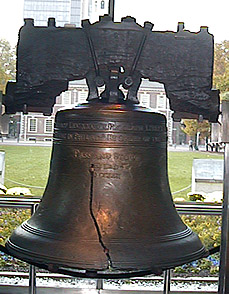|
The Liberty Bell

The colonists decided to celebrate the 50th anniversary of William Penn's Charter of Privileges by ordering a Liberty Bell. It was made by Thomas Lester of England in 1752. The bell weighs 2000 pounds. It is 70% copper and 25% tin. Shortly after it arrived in Philadelphia the Bell cracked. Craftsmen recast the bell using the metal from the old bell. It also was defective. Then John Pass and John Stowe cast a new one and their names appear on the bell, along with the city and date, along with this inscription:
The Declaration of Independence was signed in Philadelphia in 1752 by the members to the Continental Congress. They rang the Liberty Bells to celebrate their independence from King George of England. Since then. It has become a symbol of American freedom. On June 7, 1753, the bell was hung in the tower of Independence Hall. During the American Revolutionary War the British captured the city of Philadelphia in 1777. To keep the Liberty Bell safe, it was moved to Zion's Reformed Church in Allentown, Pennsylvania. Later, when the British left Philadelphia in 1778, it was moved back. Today, the Liberty Bell hangs in Philadelphia at the Liberty Bell Pavilion on Market Street. Because of its poor condition, it is rang very gently every July 4th.
Copyright © 2003. All Rights Reserved |
